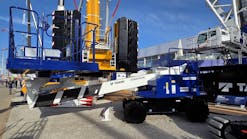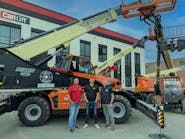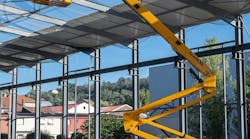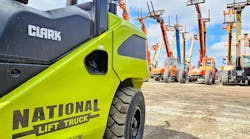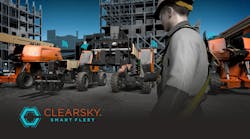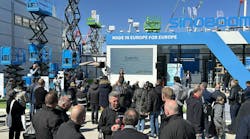Here are just some of the accessories designed to keep operators safe.
For years aerial equipment manufacturers have been finding ways to improve safety for rental companies and end users alike. Safety is the top priority as aerial equipment can be dangerous to the operator and those around the machine.
Companies have found ways to combat the dangers by adding stricter safety measures and creating safety equipment and accessories. Here are a few examples of what some manufacturers are offering.
Skyjack has developed a full line of accessories for its scissor lifts, boom lifts, and telehandlers called Accessoryser. Accessoryser consists of a secondary guarding lift enable, XStep, board carriers, tool trays, light duty pipe racks, heavy duty pipe racks and fluorescent tube carriers.
“One of the key considerations is that when a manufacturer designs a machine, safety is a key consideration and there is significant testing that is completed to ensure the safety of the machine in line with a variety of global regulatory requirements,” says Malcom Early, vice president of marketing at Skyjack.
In the equipment industry, rules and regulations are constantly changing to ensure operator safety and Early echoes that importance.
“When changes or modifications are independently made in the field it is important that these design considerations are not compromised,” Early says. “Skyjack as a manufacturer takes great care during accessory development. So that the user has the comfort of knowing that, these manufacturers approved, accessories safely add functionality to the machine and convenience for the operator, whether it is helping to get materials up to the worksite, protecting equipment from weather or enhancing productivity.”
Inspiration for Skyjack’s Accessoryser safety line came about by observing machines and seeing them in action.
While observing, Early says that manufacturers will often tell the operator, “Hey, don’t do that!” and that simple phrase can sometimes develop into an idea for a safety accessory product.
“A good example would be our recently introduced XStep for use on DC scissors,” he notes. “It was not uncommon for us to see operators standing on railings to gain a little more height and/or to access small areas, a good example being accessing through suspended ceiling tiles. Using Skyjack’s XStep helps eliminate this dangerous practice and maximizes reach and productivity by providing operators with safe, increased access into and around tight, restricted spaces.”
XStep consists of a swing-down base with full height railings that is securely mounted on the mid rails of the scissor lift. The operator can step up (19 inches) into the XStep, close the top rail and work safely gaining extra jobsite access, Early explains.
“Important in the design has been the ability for one person to install the XStep using no special tools or lifting equipment and to do so in five minutes. It is retrofittable to previous Skyjack DC scissor models and can easily be moved from one scissor to another, increasing a rental company’s fleet flexibility,” Early says.
Haulotte’s safety DNA
At Haulotte product marketing manager for Americas Paul Jensen says safety is part of the Haulotte DNA.
“We at Haulotte believe that mobile elevating work platforms (MEWPs) are the safest way to work at height,” Jensen says. “Haulotte Group was the first MEWP manufacturer to be awarded International Powered Access Federation’s (IPAF) ‘Sustaining Member’ designation in September 2018, after the company announced that all future new products would be electrical.”
Jensen points to IPAF’s 2021 Global Safety Report, which states from 2019 to 2020 about 41 percent of the fatal and major incidents reported internationally while using equipment related to the construction field and most of the fatal incidents include electrocution falls from platform and entrapment.
“All Haulotte machines are designed with safety in mind from the beginning,” he says. “MEWPs are considered the safest method of working at height because the operator's feet are firmly planted on the platform surface while working at height. The biggest competition any player in the MEWP industry faces is when operators use less safe methods to work at height. Haulotte’s success hinges on making MEWPs the safest and best alternative for working productively at height.”
One way Haulotte is keeping operators safe while on aerial equipment is the creation of its Activ’Shield Bar, a secondary guarding system that’s available on boom lifts as well as the company’s Pulseo family of electric rough terrain scissor lifts. The bar provides protection from entrapment hazards while also creating a space for the operator to safely exit the dangerous situation after activation. The operator can then perform a simple system reset to get back to work quickly.
While accessories and parts are a main safety factor at Haulotte, the company even considers paint as another increased safety measure.
Haulotte’s new paint scheme for machines features a high visibility red paint such as red handles on entry doors, maintenance prop stands and the upper control box docking station on the new Pulseo rough terrain scissor lifts.
“Operator and machine safety will continue to be at the forefront of Haulotte’s strategy and mission. We are continually striving to develop new safety solutions that ensure operators have the safest possible experience while using our machines,” Jensen says.
No compromises on safety at JLG
Jennifer Stiansen, director of marketing at JLG says safety is not something the company, which has been making aerial equipment for 53 years, compromises. Stiansen says OHSA identifies Focus Four hazards as electrical hazards, fall hazards, struck-by hazards, and caught-between hazards. JLG’s SkyGuard technology focuses on lessening the risk of caught-between hazards.
“Caught-in, or caught-between, injuries occur when an operator gets pinned between two or more objects,” Stiansen says. “When the SkyGuard sensor is activated, by about 50 pounds or 23-kg of force, it stops most machine functions that are in use at the time. It also offers reverse functionality, which means that after stopping the machine, the sensor can temporarily reverse, or undo most functions that were in use at the time of activation.”
Another way JLG keeps operators safe is with the SkyGuard SkyLine, which is standard on most new JLG boom lifts. It consists of a slim wire rope design rather than a bar and is bolted to the left side of the platform with an opposing magnetic connection.
“If the operator contacts the cable and the magnet detaches, the system stops all boom lift functions, then momentarily reverses or undoes most functions that were in use when the system was activated,” Stiansen explains. “The safe use of aerial lifts on job sites is critical to JLG; it is our number one priority. Everyone should go home in the same condition they went to work. That’s why we’ve designed many of our safety accessories and protective solutions to be active, rather than passive, thereby mitigating job sites risks and/or preventing accidents before they occur.”
Stay in the safety zone
Bronto Skylift’s Bronto+ control system monitors outreach at all times based on the cage load and outrigger set up and prevents users going outside the calculated safe reach zone. Bronto’s latest development feature is called safety drive. Safety drive is a system that automatically operates back to the starting point using the same route.
“In case there is a medical emergency, or something happens to the operator and he/she is unable to operate, the ground operator can use the safety drive function to return the cage back via the same route it was driven up,” says Johanna Kulmala, marketing manager at Bronto Skylift. “This is beneficial when operating in difficult to reach places among obstacles. The system also has situation-related help texts and hints available, as well as a quick manual.”
Genie’s Lift Power system aids work-at-height tasks such as welding that might require power in the platform. The Genie Lift Power system includes a new generation of hydraulically driven generators. A three-phase 240V (60 Hz) kW generator solution is uniquely configured for North American boom lift welders to run heavy-duty weld machines.
“Delivering power almost immediately with just the flick of a switch, the modernized system means fewer interruptions when using generator-to-power tools, an important upgrade, particularly for welding at height,” says Bryan Williams, product manager at Genie.
Another safety accessory Genie provides is the Genie Lift Tools Access Deck for scissor or boom lifts, which provides a secondary surface to work from. The Genie Lift Tools elevates operators 22 inches (0.56 m) above the platform floor.
“This extra boost can be just what is needed to safely increase productivity for applications that take place in restricted spaces,” Williams says. “In addition to improving jobsite efficiency, accessories like the Access Deck can reduce equipment rental costs because they could, in some cases, eliminate the need to rent a second lift with a smaller platform and/or lower occupancy for those hard-to-reach areas or other specialty jobsite needs.”
Williams noted that most of Genie’s accessories are designed to be used across multiple models, which increases the versatility of an equipment owner’s fleet.
Genie’s Lift Guard Platform Mesh family of accessories is designed to prevent dropped objects falling from aerial worksites.
The lift guard platform provides three options for operators to choose from, half-height aluminum, full-height aluminum and removable woven screen. The mesh accessories are engineered to help operators keep jobsite materials and tools from falling out of boom platforms while working at height.
Most companies would agree that keeping operators of these machines and those around them safe is the number one priority. Safety measures aren’t just about equipment but proper training and making sure the operator knows how to use any accessories and add-ons are used correctly. Safety measures are constantly evolving and manufacturers are doing the same by adding technology to their equipment to better keep operators safe.
